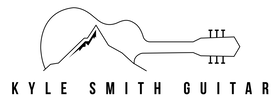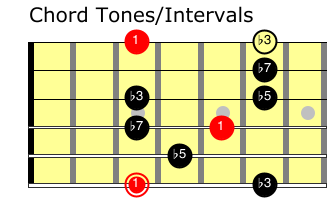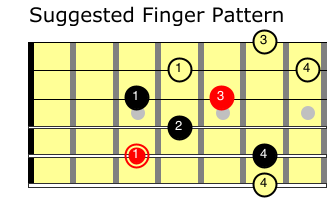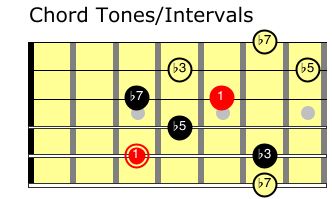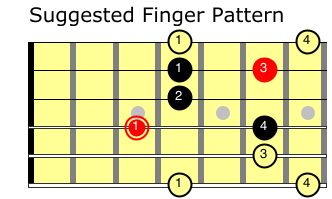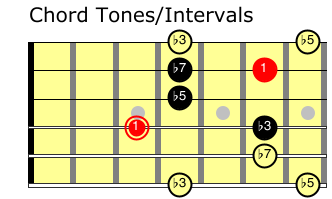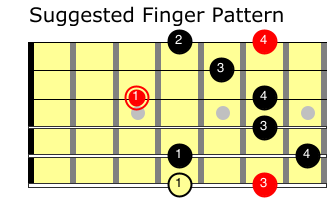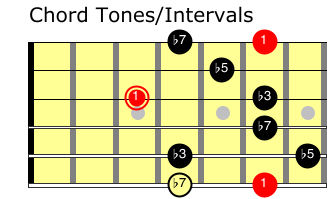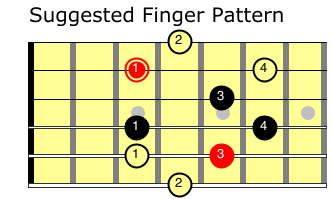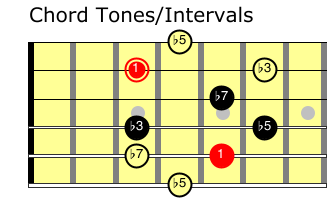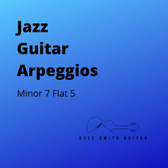 Minor 7b5 arpeggios are an important part of every jazz guitar players tool kit. These arpeggio shapes let you outline minor 7b5 chords as you improvise and play melodies and and important part of the minor 2 5 1 progression. Minor 7b5 arpeggios are based off of a minor-type finger pattern, meaning that the shape is related somehow to the minor pentatonic scale. In fact, the minor 7th arpeggio is only two notes different than your minor pentatonic scale. What do you need to know first?For jazz guitar players, it will be helpful if you also know your major 7th, dominant 7th, and minor 7th arpeggio shapes - but not absolutely necessary. If you already know your minor pentatonic scale shapes, these arpeggios will be easier for you. It's just 2 notes different. Knowing the notes on the guitar neck is probably the most important thing you need to know if you want to actually be able to use these arpeggios in your playing. Click here to get a review of the notes on the neck. If you're itching to get started right away, use the fretboard map below as a reference for your note names. How to practice minor 7b5 (min7b5) arpeggios.Work on one arpeggio shape at a time. Focus on the finger pattern first - the most important thing in the beginning is to get a shape into your muscle memory. Once it's easy to play, move on to the next one. Focus on getting repetitions for each arpeggio shape. The more times you play it, the easier it will get, and the memorization will take care of itself. Be sure to practice all over the neck. These are moveable arpeggios, so by playing the shape at a different fret, you are also playing in a different key. More importantly for playing purposes, different areas of the neck get your fingers used to different fret spacings, and how the arpeggio shape looks under your fingers at different parts of the neck. What is a minor 7b5 arpeggio?An arpeggio is a chord played one note at a time. If you are playing a minor 7b5 arpeggio, you are outlining a half diminished or min7b5 chord in a melodic way, rather than strumming the notes of the chord all at once. The minor 7b5 arpeggio is made up of 4 notes - a root (1), a minor or flat third (b3), a flat fifth (b5), and a minor or flat seventh (b7). For the third and the seventh - the correct music theory term for these intervals is minor, and for the fifth, the correct theory term is diminished. When we're talking about chords in jazz I prefer to use the term flat - it makes more sense with the types of chords we deal with in jazz guitar. Both terms are correct, so use what makes the most sense in your own head. 5 Minor 7b5 Arpeggio ShapesIn our system, there are 5 different patterns for the minor 7 flat 5 arpeggio, starting on the 6th, 5th, 4th, 3rd, and 2nd strings. Each pattern presents a slightly different, but related finger pattern. You'll probably find that you like some of these patterns better than others, and that's ok! Just make sure you practice all of them a little bit. For each shape below you'll find 3 different graphics:
First, focus on the finger pattern and the practice example so you can get the basic pattern under your fingers. Once it's easy to play, start working on keeping track of the chord tones - this will improve your ear training and usable theory knowledge. 6th String FormPractice Example5th String FormPractice Example4th String FormPractice Example3rd String FormPractice Example2nd String FormPractice ExampleMore Ways To PracticeRepetition. Getting arpeggio shapes into your muscle memory is a critical first step to being able to use them in your playing. If you have to think about where your fingers are going, it will be hard for you to play creatively. If you don't need to think about where your fingers are going, you can pay attention to the music you are hearing in your head. Here's a drill I like:
Continue with this process until you have played the same key twice (13 total repetitions). If you're still feeling good, reverse the process and continue until you're back where you started (26 total repetitions). This exercise gets you used to playing your arpeggio shapes at every possible point on your guitar neck, and really helps get the patterns into your muscle memory. You can also work a single shape through the cycle of 4ths or cycle of 5ths - this is helpful for learning and recalling the note names along each guitar string. Use your new arpeggio shape in songs. Choose a song you're familiar with, and choose one of the arpeggio shapes above to focus on. Whenever a minor 7b5 chord appears in that song, find a place to play the arpeggio shape for that chord. This will make you jump around the fretboard a little bit, but it's a good way to practice a single arpeggio shape in a little bit of context. Repeat this process with the other 4 arpeggio shapes. Experimentation is the most important thing. If you want to be able to improvise using your minor 7b5 arpeggios, you need to practice improvising with your minor 7b5 arpeggios. Instead of just playing the arpeggios up and down, try to create a melody or a riff that you like. Too many guitar players practice very mechanically, and wonder why they struggle to play creatively - make creative playing a part of your regular practice routine. Things To Think AboutMinor 7b5 arpeggios are going to be a valuable part of your jazz guitar skill set, and your first step is to get these arpeggio shapes into your fingers and onto your guitar fretboard.
Once you have the muscle memory, try to start playing creatively with each arpeggio shape, and put them to work in songs you are playing. With practice, you'll be able to easily put these arpeggio shapes to work in your own jazz guitar playing. Keep practicing, and let me know how it goes.
0 Comments
Your comment will be posted after it is approved.
Leave a Reply. |
